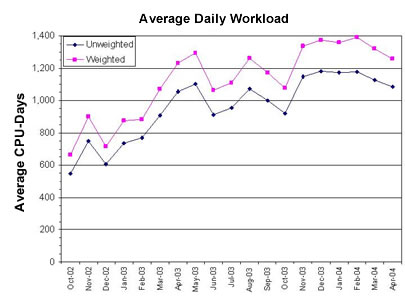|
|||||||||||
|
|
ESDCD News Home > System Metrics at the NCCS NCCS HighlightsSystem Metrics at the NCCSA lot goes on behind the scenes at the NASA Center for Computational Sciences (NCCS) that most users never see but that is important to the effective management of the Center. Information is gathered and analyzed each month on the usage of the computing and storage facilities. This information allows NASA management to track trends in usage, predict the impacts of system changes, and plan for High End Computing (HEC) and storage needs for the Earth and space science community. Figure 1 shows the increase in usage of the largest NCCS HP/Compaq system over the past year and a half.
The maximum number of processors available for batch processing is 1,292, so the system utilization consistently exceeded 90% from November 2003 through February 2004. Large parallel systems like this one are commonly considered to be saturated when they reach 85-90% utilization. Because the system is composed of processors with two different speeds, the weighted average can exceed 1,292 CPU-Days. The information gained from tracking the metrics at the level shown above is important for tracking the overall utilization of the various systems at the NCCS and for long-term capacity planning, but system metrics are also tracked at a much finer level of granularity to determine the usage of major organizations over time. The usage of the same system by organization for March 2004 is shown in Figure 2.
Many other breakdowns of the data are examined for a more complete perspective of how the systems are being used by hour of the day, day of the week, job size, workload, queues, and groups. This allows NASA management to identify trends or deficiencies in system utilization and take action based upon quantitative data. The NCCS has changed batch queue structures in response to trends identified by this analysis and provided feedback to major user groups to improve job scheduling and make better use of the resources. The information is also presented to NASA management and the NCCS Customer Board as part of the decision making process on requests for resource allocation. For example, as the full HP/Compaq system was being brought into production, the NASA Seasonal-to-Interannual Prediction Project had almost exclusive use of a large part of the system. As usage grew on the system, other groups’ workloads were shifted through queues to better distribute the load. More recently the Goddard Institute for Space Studies (GISS) needed additional capacity to meet deadlines for the Intergovernmental Panel on Climate Change. To help GISS meet its requirements, queue limits were adjusted to allow the Institute to use more resources on the system; its usage has more than doubled over the past three months. The NCCS maintains a database of detailed system accounting information that allows reports to be generated down to the level of individual user batch jobs. Although this level of detail is rarely needed, when the NCCS rebuilt and reconfigured the systems this summer, the usage data by individual user was one of the criteria that determined the scheduled return to service of the user community. Similarly, detailed usage information also impacts management decisions during the Fiscal Year Initiation process. Questions about system accounting data should be directed to NCCS User Services at support@nccs.nasa.gov. |
||||||||||



